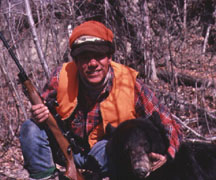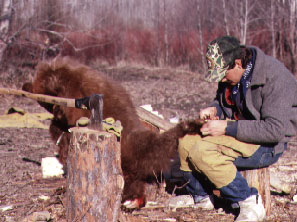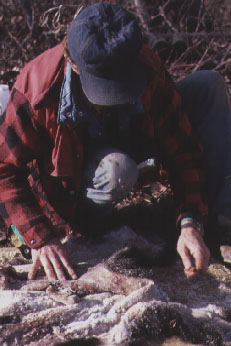|
|
 |
 |
Trophy & Meat Care by Bob Knopf
The quality of the meat and the quality of the mount depends almost entirely upon how the animal is cared for. Meat Care To obtain the best meat flavor clean the animal as soon as possible. In warm temperatures this is immediately, even if it means tracking and working all night in a rainstorm. As you field dress your animal, remove all blood-stained and contaminated meat. Any contaminated meat should be wiped clean and flushed with water. Opinions vary as to how long to age big game meat. Some enjoy meat freshly butchered and wrapped; others prefer to allow meat to age similar to quality beef. Let your culinary tastes be your guide. Aging tenderizes meats, and is my preferred method. To obtain the finest, most delicate flavor, age a big game animal at 35-45 degrees F protected from sun and rain for about a week, or until mold just begins to form in the body cavity. When possible (if the weather is cool enough), age your meat with the skin on. This keeps the meat moist and in excellent condition. If you haven’t tried this you will be amazed at the tenderness of the meat. Mount Care
If you know ahead that you may want to mount your trophy, call your local taxidermist before the hunt. They will tell you how to care for you animal to assure a quality mount. Many will send you information on skinning and care of the hide. Be sure to know ahead of time where to make your cuts so you don’t ruin the hide. Head mounts require incisions along the top or back of the animal, and require keeping the cape intact all the way back through the front leg. Many hunters make the mistake of cutting too far forward to remove the hide, ruining their mount. It is relatively easy to skin a big game animal; however, it takes care and patience. This is a major advantage of guided hunts. Guides are trained to care for your cape and horns all the way to the taxidermist.
Upon fleshing out the hide it should be thoroughly salted and hung to dry. The salt will liquify some fat. This causes fluid to build up on a hide so it must be aired and drained. Do not put it in a plastic bag or other airtight container. Hang the hide open, or fold loosely, protecting it from water and rain. Allow excess water to drain off. If the hide will remain in this condition for more than a day it should be kept cool and examined daily, adding fresh salt each day.After such drying, which may take from two to four days, the hide is usually dry enough that it can be re-salted and readied for transportation. Continue to refrain from putting the hide in a plastic bag or any airtight container.
Upon reaching home, the hide should either be kept frozen, or examined again, re-salted, and taken to your local taxidermist for processing. The hide, along with the animals measurements, should be given to your taxidermist along with information on the type of mount you desire. Select your taxidermist carefully. All trophy mounts cost approximately the same, so don’t let price be a guide. Visit your taxidermist and examine similar mounts. Ask for references and speak with other customers. The appearance, and quality of your mount is directly related to the skill and competence of your taxidermist. Many taxidermists will send you a color brochure showing their work. At the taxidermist, your hide will go through several stages before it is ready for pick up. The taxidermist will immediately examine it for proper processing. All nooks and crannies that could be spoiling will be examined. It will be repacked in salt, wrapped up, identified with your name, and frozen for transport to a hide processor. This generally takes from six to 20 weeks depending on the season and the time of year. Patience is required here, because it always takes longer than you’d like. Once your trophy is completed and taken home, find a suitable location. It will require little care. An occasional dusting and damp wiping will keep your trophy mount looking fresh and new for many years to come. |
|
|
| Site design by Outdoor Management Network Inc. Copyright © 2005 Outdoor Management Network Inc. America Outdoors® is a registered trademark of Outdoor Management Network Inc. |
 Following a successful hunt and the taking of a fine trophy
many hunters choose to re-live the memory by having their
trophy mounted. Also, there is no finer eating than properly
prepared deer, elk, bear, or antelope.
Following a successful hunt and the taking of a fine trophy
many hunters choose to re-live the memory by having their
trophy mounted. Also, there is no finer eating than properly
prepared deer, elk, bear, or antelope. For mount preparation, when field dressing your
animal, be careful not to damage the skin. Avoid
getting blood on the hide. You need to record
measurements of ther skull, neck, and body at various
places, plus any relevant lengths.
For mount preparation, when field dressing your
animal, be careful not to damage the skin. Avoid
getting blood on the hide. You need to record
measurements of ther skull, neck, and body at various
places, plus any relevant lengths. For best cape care, it is important that the
animal be skinned before any damage can
occur to the hide. Cautions include to be sure
to remove all flesh from the backside of the
hide and to cool and salt the hide quickly. In a
bear, for example, care should be taken to
remove all of the flesh from the paw and the
pad area well up into the toes.For head mounts,
the ears need to be turned. This assures that the
hair does not slip and the pelt can be properly
preserved. These are not, however, jobs for
novices.
For best cape care, it is important that the
animal be skinned before any damage can
occur to the hide. Cautions include to be sure
to remove all flesh from the backside of the
hide and to cool and salt the hide quickly. In a
bear, for example, care should be taken to
remove all of the flesh from the paw and the
pad area well up into the toes.For head mounts,
the ears need to be turned. This assures that the
hair does not slip and the pelt can be properly
preserved. These are not, however, jobs for
novices. To transport the hide, fold it, tie in a bundle, and place it
in a cloth duffle bag. A cloth bag is best because it permits
air circulation and lets fluid drain. The hide should be
transported to the taxidermist as quickly as possible. If
there will be a significant delay, the best option after salting
and draining is to freeze the hide. This retains its condition
for long periods of time, and is especially important if the
temperature is warm.
To transport the hide, fold it, tie in a bundle, and place it
in a cloth duffle bag. A cloth bag is best because it permits
air circulation and lets fluid drain. The hide should be
transported to the taxidermist as quickly as possible. If
there will be a significant delay, the best option after salting
and draining is to freeze the hide. This retains its condition
for long periods of time, and is especially important if the
temperature is warm.